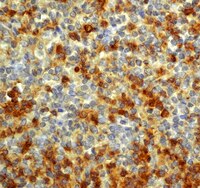MAB5372 Sigma-AldrichAnti-Astrocytomas Antibody, a marker for Low Grade Astrocytoma, clone J1-31
Detect Astrocytomas using this Anti-Astrocytomas Antibody, a marker for Low Grade Astrocytoma, clone J1-31 validated for use in WB, IC, IH(P).
More>> Detect Astrocytomas using this Anti-Astrocytomas Antibody, a marker for Low Grade Astrocytoma, clone J1-31 validated for use in WB, IC, IH(P). Less<<Recommended Products
Overview
| Replacement Information |
|---|
Key Specifications Table
| Species Reactivity | Key Applications | Host | Format | Antibody Type |
|---|---|---|---|---|
| Gp, H, M, R | WB, ICC, IH(P) | M | Ascites | Monoclonal Antibody |
| Description | |
|---|---|
| Catalogue Number | MAB5372 |
| Replaces | MAB5314 |
| Brand Family | Chemicon® |
| Trade Name |
|
| Description | Anti-Astrocytomas Antibody, a marker for Low Grade Astrocytoma, clone J1-31 |
| References |
|---|
| Product Information | |
|---|---|
| Format | Ascites |
| Presentation | Ascites fluid. Liquid. |
| Quality Level | MQ100 |
| Physicochemical Information |
|---|
| Dimensions |
|---|
| Materials Information |
|---|
| Toxicological Information |
|---|
| Safety Information according to GHS |
|---|
| Safety Information |
|---|
| Storage and Shipping Information | |
|---|---|
| Storage Conditions | Maintain at -20°C in undiluted aliquots for up to 6 months after date of receipt. Avoid repeated freeze/thaw cycles. |
| Packaging Information | |
|---|---|
| Material Size | 100 µL |
| Transport Information |
|---|
| Supplemental Information |
|---|
| Specifications |
|---|
| Global Trade Item Number | |
|---|---|
| Catalog Number | GTIN |
| MAB5372 | 04053252464003 |
Documentation
Anti-Astrocytomas Antibody, a marker for Low Grade Astrocytoma, clone J1-31 SDS
| Title |
|---|
Anti-Astrocytomas Antibody, a marker for Low Grade Astrocytoma, clone J1-31 Certificates of Analysis
| Title | Lot Number |
|---|---|
| MOUSE ANTI-ASTROCYTES (MARKER FOR LOW GRADE ASTROCYTOMA) MONOCLONAL ANTIBODY | 3088366 |
| MOUSE ANTI-ASTROCYTES (MARKER FOR LOW GRADE ASTROCYTOMA) MONOCLONAL ANTIBODY | 2932383 |
| MOUSE ANTI-ASTROCYTES -2621528 | 2621528 |
| MOUSE ANTI-ASTROCYTES -2652173 | 2652173 |
| MOUSE ANTI-ASTROCYTES -2714467 | 2714467 |
| MOUSE ANTI-ASTROCYTES -2790072 | 2790072 |
| MOUSE ANTI-ASTROCYTES -2815178 | 2815178 |
References
| Reference overview | Pub Med ID |
|---|---|
| Up-regulation of reactive astrogliosis in the rat glioma 9L cell line by combined mechanical and chemical injuries. Malhotra, S K, et al. Cytobios, 89: 115-34 (1997) 1997 | 9363621
 |
| Diversity among reactive astrocytes: proximal reactive astrocytes in lacerated spinal cord preferentially react with monoclonal antibody J1-31. Malhotra, S K, et al. Brain Res. Bull., 30: 395-404 (1993) 1993 | 8457889
 |
| Novel astrocytic protein in multiple sclerosis plaques. Malhotra, S K, et al. J. Neurosci. Res., 22: 36-49 (1989) 1989 | 2926840
 |
| Enhanced expression of a protein antigen (J1-31 antigen, 30 kilodaltons) by reactive astrocytes in lacerated spinal cord. Predy, R, et al. J. Neurosci. Res., 19: 397-404, 466-7 (1988) 1988 | 3385801
 |
| A new "marker" protein for astrocytes. Singh, R, et al. Biosci. Rep., 6: 73-80 (1986) 1986 | 2421799
 |














